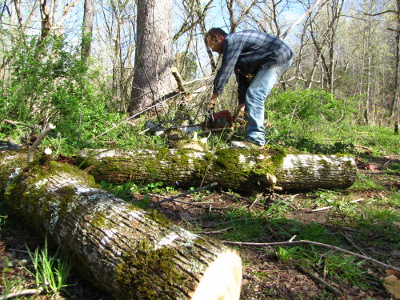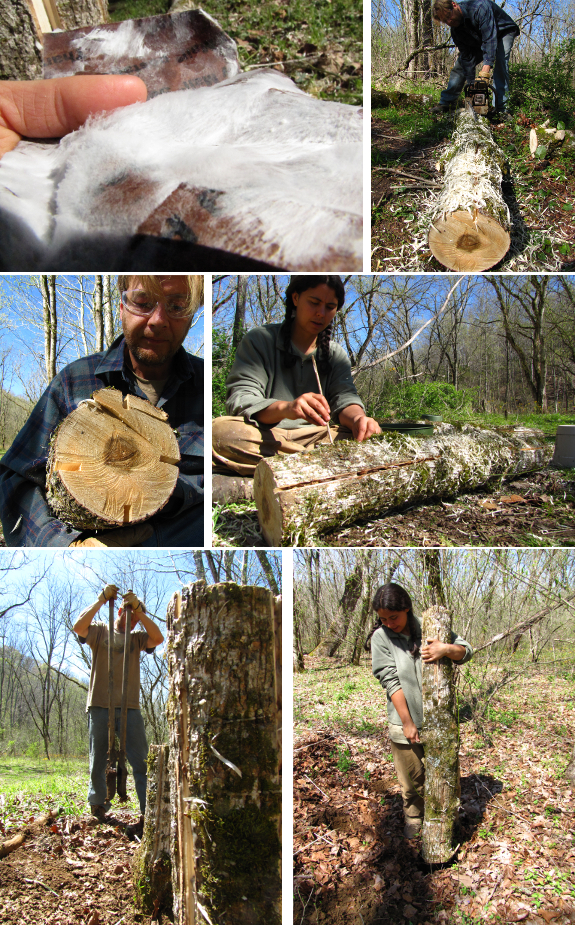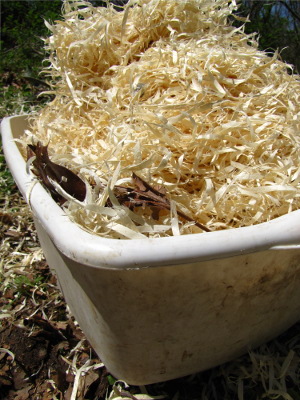
Using the whole buffalo
 There's
an old saying that American Indians on the Plains used every part of
the buffalo. Although I'm aware that the saying is part of the Noble
Savage image and
might not be technically true, I still think it's a great analogy for
our goals as permaculture-inclined homesteaders. So when Mark cut
down a box-elder to make way for an everbearing
mulberry, I decided
to see how much of that tree we could use.
There's
an old saying that American Indians on the Plains used every part of
the buffalo. Although I'm aware that the saying is part of the Noble
Savage image and
might not be technically true, I still think it's a great analogy for
our goals as permaculture-inclined homesteaders. So when Mark cut
down a box-elder to make way for an everbearing
mulberry, I decided
to see how much of that tree we could use.

We cut three big logs
and used our
new gash method to inoculate them with homegrown oyster
mushroom spawn. Mark dug deep holes and dropped in the logs to
turn them into no-work mushroom
totems right there
in the moist shade of the floodplain. Then we set to work
inoculating the stump --- a way of taking advantage of even the roots
of the tree. Since we pass this spot twice a day while walking
Lucy, the resultant mushrooms won't go to waste.
The rest of the wood
will soon be cut into firewood for next winter. We've discovered
that box-elder makes perfect kindling, and is also all we need for most
of the winter to keep the well-insulated East Wing warm.
 Finally,
I gathered up the big shreds of sawdust kicked up by the
chainsaw. Assuming I haven't let our
chicks die in the
shell with temperature variations, they're due to hatch this weekend
and will need some bedding for the few days they'll spend inside.
I'd been wondering what I'd use and was thrilled to see such prime wood
shavings.
Finally,
I gathered up the big shreds of sawdust kicked up by the
chainsaw. Assuming I haven't let our
chicks die in the
shell with temperature variations, they're due to hatch this weekend
and will need some bedding for the few days they'll spend inside.
I'd been wondering what I'd use and was thrilled to see such prime wood
shavings.
The only part of the
box-elder that is currently going to waste is the smallest
branches. I dragged them into a small brush pile, though, and
hope they'll rot down and turn into a breeding ground for worms and
other critters. Since the spot is inside a soon-to-be chicken
pasture, hopefully even that fertility will eventually wind its way
into our bellies.
Want more in-depth information? Browse through our books.
Or explore more posts by date or by subject.
About us: Anna Hess and Mark Hamilton spent over a decade living self-sufficiently in the mountains of Virginia before moving north to start over from scratch in the foothills of Ohio. They've experimented with permaculture, no-till gardening, trailersteading, home-based microbusinesses and much more, writing about their adventures in both blogs and books.
Want to be notified when new comments are posted on this page? Click on the RSS button after you add a comment to subscribe to the comment feed, or simply check the box beside "email replies to me" while writing your comment.

I recently found your blog and have been diving into it with a passion! Ive went back and read the past post and the more I read the more I am inspired and to be quite honest a bit jealous. I would love to be able to do what you two are doing and frankly my wife and I have started making small steps even before we knew we were. We live in a 1 bedroom home I bought before graduating college and getting married and while its small it does fit all our needs. Ive spent many hours putting in a food garden on our little 50x150 lot and have expanded to borrowing a portion of her grandmothers large yard for more melons, veggies, and what not. We have our own compost pile, frequently get items off the Freecycle website in our area or free off craigslist so items arent going to a landfill.
The only thing we noticed we have been doing it seems more than you two is I grew up in the outdoors hunting and fishing. I loved your comments about hunting your deer, but ive noticed you two dont spend alot of time hunting or fishing local game. My wife, who was not raised in a hunting family, has taken to wild game and loves it. We started with venison, then turkey, and slowly moving her into geese, duck, rabbit, squirrel, raccoon, wild ram and wild hog, and whatever else is legal to hunt. While I do understand the chickens and possibly adding livestock, I wonder if you two could add some future benefits from started to use the wild game around your area.
Keep up the great work and Ill keep devouring your writing! David in KS
You've got a great point about the value of hunting and fishing in a self-sufficient lifestyle. The reason we haven't taken more advantage of wild meat is various. We weren't raised hunting, so we'd really need to do a lot more target practice before we could reliably bring down wild animals for meat. And I've got some weird aversion to fish, which makes that low-hanging fruit less enticing. (One of these days, I'm going to teach myself to eat fish!)
I also have a deep preservationist ethic, and while deer are overpopulated and lack predators in our area, most of the other animals that people hunt aren't. We do see wild turkeys from time to time, but they're not very common and I feel like I'd have to be in real need of meat to lower their population further.
Now, Canada Geese are another matter in certain areas, although I'm not sure if I could get permission to hunt on golf courses and in parks. They'd definitely fit the profile of wild animals that need some whittling down. If we had wild hogs here (luckily we don't!), I'd go after those too since they're an invasive species.
They'd definitely fit the profile of wild animals that need some whittling down. If we had wild hogs here (luckily we don't!), I'd go after those too since they're an invasive species.
Thanks for the thought-provoking comment!
While I dont know exactly your local game situation, I do know in our area whitetails are overpopulated due to lack of predators which you were right on the money! The geese situation is an odd one, government regulations only allow a few birds a hunter a day, but it seems those numbers are out dated population control figures and limits.
I think once you get some practice you both will find that joy of harvesting your own meat like with the food you grow and produce yourselves! Definetely possible to tan your own hides at home to further use game you've taken as well.
The fishing part Ive noticed others have used in homesteading by "farming" their own fish. Alot of what ive seen on urban homesteaders is they raise their own tilapia and other fish in the same manner one would raise chickens or goats. Might be something to consider with your available water source, land, and homesteading lifestyle.
I think that there are a lot of outdated hunting regulations about deer too, trying to get people to focus on killing bucks rather than does.
I used to be intrigued by the idea of tanning our own hides, then I started pondering what we'd actually do with them. Mark and I think it's a big deal if we buy a new pair of pants in a twelve month period --- we certainly aren't big clothes people!
I've been interested in farming fish, especially if we can train me to eat them. Around here, a lot of people find cold mountain streams to raise trout --- our mini creek is probably too warm, though.
Around here, a lot of people find cold mountain streams to raise trout --- our mini creek is probably too warm, though.